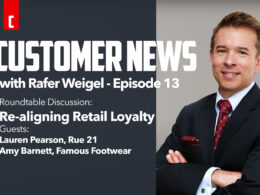After two years of accelerating the transition to digital commerce because of the pandemic, it’s time for companies to refine their digital experience. According to Forrester, organizations will move from a reactive mode to reimagining their customer experience in 2022 and beyond, “leveraging the now chronic disruption as a catalyst to reinvent and reinforce experiences that delight customers.”
By Rich Minns, Group Commerce CTO at Capgemini Americas
As digital commerce has become the norm, customers expect brands to craft seamless shopping experiences across all channels. Some digitally mature companies met customers’ evolving commerce standards during the height of the pandemic, quickly building and deploying customer-centric digital experiences. Now, the same visionary organizations are looking to create the next wave of digital commerce advancements, and other brands are trying to keep pace.
The most effective and sustainable way to deliver better digital commerce experiences over the long run is to empower the people closest to customer experience. Marketers, sales and service teams, and designers can effectively create and update experiences that meet customers’ needs and expectations—if they have the right resources. However, giving these teams what they need requires dismantling monolithic commerce structures and replacing them with modular commerce components that connect seamlessly in a variety of configurations. These components are the building blocks of composable commerce architecture. They allow organizations to craft commerce experiences as quickly as customer demands evolve, by decoupling the front-end user experience from the back-end systems that enable it.
Why remodel your organization’s commerce monolithic architecture?
Composable commerce is agile commerce, and the benefits go well beyond CX enhancements. By 2023, companies that have composable commerce resources will be able to deploy new features 80% faster than competitors relying on legacy commerce systems, per Gartner. Because customers increasingly base buying decisions on their experiences with brands, this difference in the speed of innovation can provide a hard-to-overcome competitive advantage. Crafting commerce from composable elements also saves time and money by eliminating the 3- to 5-year commerce platform upgrade cycle.
Composable commerce is also resilient commerce. For example, one retail brand using composable commerce elements found that its website was able to withstand a traffic surge three times larger than its previous peak traffic, and a corresponding transaction peak 10% higher than before. While retail websites with legacy architecture could easily slow to a crawl or crash because of such a surge, this retailer’s composable elements automatically scaled to meet demand, while alerting the relevant teams of the traffic and transaction spike. The result was robust site performance and a seamless experience for customers, with no interruption in the flow of orders.
Moving from monolithic to composable commerce
As exciting as composable commerce is, not every organization will be ready to start their transformation now. Startups that are selecting their technologies, and companies that are digitally mature enough to navigate a major technology transition, are in the best position to adopt composable elements to deliver differentiated crafted commerce experiences.
That’s because moving away from monolithic, tightly integrated architecture to headless, modular architecture requires decoupling the brand’s user interfaces from systems for managing enterprise resource planning, customer relationships, marketing content, warehouse operations, and product lifecycles. Companies that want to shift from monolithic to composable commerce structures have two options.
One option is to separate presentation layer components like templates and HTML from the monolithic core, using an application programming interface (API) to reconnect them. This approach preserves the company’s resources, but it’s not a strategic long-term solution because that monolithic structure is still at the heart of the architecture. A better option is to break up the monolith and gradually replace different functions with headless solutions. This approach is more expensive, but deployment can be paced to fit budget requirements and to address top pain points first.
Technology tools for faster, more flexible commerce
Gradual replacement is also more sustainable over the long term if companies choose modular solutions, which are available from multiple sources. For example, the nonprofit MACH Alliance, which Capgemini participates in, certifies and standardizes applications to create “open tech ecosystems that are Microservices based, API-first, Cloud-native SaaS, and Headless.” These components provide the freedom to snap together high-quality elements to build out the latest version of their digital experience with the added security of an agnostic third party having already assessed the capability of the components.
In theory, combined with a composable approach, the process becomes like building a model with interlocking bricks that are always compatible no matter how you configure them. In practice, MACH allows teams to build new business channels or support new devices without the slow, resource-intensive process of updating the monolithic system first. The API-first approach allows quick rollout of new initiatives so companies can get feedback fast, make changes quickly, and scale up as demand rises without dramatically increasing the infrastructure budget.
Reaching MACH speed in digital transformation
Implementing a transition to the crafted commerce approach requires strong support from leadership and a creative, customer-centric mindset in addition to digital maturity and the right composable elements. Then, the transition to MACH technology follows three overarching steps:
Discovery
Identify the organization’s requirements, including architectural planning and user experience/user interface (UX/UI) design requirements.
Implementation
Configure platforms, integrate composable commerce elements, connect accelerators, and customize the user experience.
Optimization
Review managed services, code, performance and security to identify areas for operational optimization.
Monitoring KPIs is also important to determine how each new commerce feature or experience is crafted and performs with customers. It’s also important to adopt a new mindset, one in which the digital experience is continuously evolving. That cultural shift can ensure that the organization has the resources and leadership support to keep crafting and developing the next great new and differentiated commerce experiences for its customers.
 Rich Minns is a commerce and customer experience leader at Capgemini Americas, overseeing architecture, development, and infrastructure and helping clients envision solutions for engaging, experience-driven commerce websites. He brings over 20 years of executive experience at Top 500 e-commerce retail companies and has led hundreds of successful commerce launches on numerous different technology platforms.
Rich Minns is a commerce and customer experience leader at Capgemini Americas, overseeing architecture, development, and infrastructure and helping clients envision solutions for engaging, experience-driven commerce websites. He brings over 20 years of executive experience at Top 500 e-commerce retail companies and has led hundreds of successful commerce launches on numerous different technology platforms.














This is so helpful from Rich as we all have to wrap our heads around the new concepts needed for Brand Personalization and good Customer Experience, but as Rich points out with this new handle – Composable Commerce – the process is to take steps towards tech one to one. This starts my education, thanks Rich.
This is so helpful from Rich as we all have to wrap our heads around the new concepts needed for Brand Personalization and good Customer Experience, but as Rich points out with this new handle – Composable Commerce – the process is to take steps towards tech one to one. This starts my education, thanks Rich.